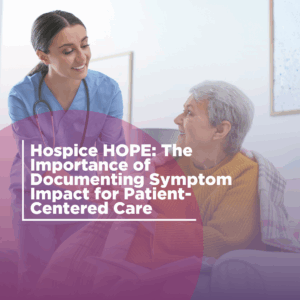Hospice HOPE: The Importance of Documenting Symptom Impact for Patient-Centered Care
In hospice care, the focus isn’t just on treating symptoms; it’s on improving the quality of life for patients and their families. This is where Hospice HOPE takes center stage, emphasizing the importance of documenting symptom impact to deliver truly patient-centered care. By understanding how symptoms affect each patient’s physical, emotional, and psychosocial well-being, hospice teams can provide care that aligns with their unique needs and goals.
What is Hospice HOPE?
Hospice HOPE stands for Hospice Outcomes and Patient Evaluation. It’s a philosophy that places the patient’s comfort, dignity, and goals at the forefront of care delivery. Documenting symptom impact is a critical part of this approach because it provides a detailed understanding of how symptoms affect the patient’s overall quality of life.
In hospice care, every patient’s journey is unique. By actively tracking and documenting symptom impact, care providers can move beyond generic treatments and embrace a truly individualized approach that prioritizes what matters most to the patient.
Why Documenting Symptom Impact Matter?
1. Moves us to Patient- Centered Care.
Documenting symptom impact allows hospice teams to focus on what truly matters to the patient. Instead of simply addressing symptoms like pain, nausea, or fatigue in isolation, it provides a holistic view of how these symptoms affect the patient’s daily life. For example:
- Pain: How does it limit mobility or the ability to participate in meaningful activities?
- Fatigue: Is it preventing patients from spending time with loved ones?
- Nausea: Is it reducing their ability to eat or enjoy meals?
By asking these questions and recording the answers, hospice providers can better tailor interventions to manage not just symptom management but the overall patient experience.
2. Improves Communication Across the Care Team
In hospice care, communication is everything. Documenting symptom impact ensures that every member of the interdisciplinary team (IDT), from nurses and physicians to social workers and chaplains, has access to the same comprehensive information.
This documentation:
- Creates a shared understanding of the patient’s condition.
- Helps align the team’s goals with the patient’s priorities.
- Reduces duplication of efforts and enhances care coordination.
When everyone is on the same page, patients and families receive more seamless, cohesive care.
3. Supports Compliance and Quality Standards
Regulatory bodies like CMS (Centers for Medicare & Medicaid Services) require hospices to document and monitor patient symptoms to ensure care quality. But beyond compliance, tracking symptom impact demonstrates a commitment to continuous improvement.
Documenting symptom impact allows hospices to:
- Identify trends and gaps in care.
- Measure the effectiveness of interventions.
- Use data to advocate for better resources or innovations in care delivery.
4. Empowers Families and Caregivers
When symptom impact is documented, families and caregivers gain a clearer understanding of their loved one’s condition. This transparency fosters trust and collaboration between the hospice team and the family, ensuring everyone is working toward the same goals.
For example, a caregiver might better understand why a loved one sleeps more during the day or avoids certain foods. These insights can help families feel more prepared and supported during a challenging time.
How to Document Symptom Impact Effectively
Transitioning to patient-centered care through documentation requires intentionality. Here are some best practices for capturing symptom impact:
1. Utilize Patient-Reported Outcomes
Whenever possible, let the patient describe how symptoms affect them. Use structured tools like:
- Symptom scales (e.g., 0–10 pain ratings).
- Quality-of-life questionnaires.
- Open-ended questions (e.g., “How has this symptom affected your daily life?”).
2. Involve the Entire Care Team
Encourage input from all members of the IDT. For example:
- Nurses and physicians can assess clinical symptoms.
- Social workers can document emotional and social impacts.
- Chaplains can explore spiritual concerns.
3. Leverage Technology
Modern hospice EMR systems simplify documentation by providing templates, prompts, and analytics tools. These systems allow teams to quickly capture and organize data, ensuring nothing is overlooked.
4. Integrate Symptom Impact into Care Plans
Documentation is only valuable if it informs care delivery. Regularly review symptom impact data during IDT meetings, and use it to adjust care plans in real time.
The Ripple Effect of Patient-Centered Care
Documenting symptom impact isn’t just about checking a box. It’s about creating a ripple effect of better care:
- Patients feel heard and valued when their experiences shape their care plans.
- Families feel empowered by transparency and collaboration.
- Hospice teams deliver higher-quality care, driven by data and aligned with patient goals.
Ultimately, this approach ensures that hospice care is not only evidence-based but also deeply compassionate, honoring the humanity of every patient.
Summary
With CMS rolling out Hospice HOPE, documenting symptom impact is no longer optional. It’s the standard for compassionate, high-quality care. This shift helps hospice organizations go beyond symptom control and into whole-person care that honors each patient’s life journey.
At Curantis Solutions, we’re proud to offer a comprehensive symptom impact workflow built to support this exact vision. Our intuitive interface displays previous symptom data at a glance, making it easy for clinicians to see changes over time and make informed, timely decisions. Our clients consistently share how much they value this clarity and how it enhances their ability to deliver outstanding care with less administrative burden.
Contact us today to schedule a demo and see how we’re reimagining hospice and palliative care to make your software experience refreshingly simple.
For more HOPE Resources, visit here.





